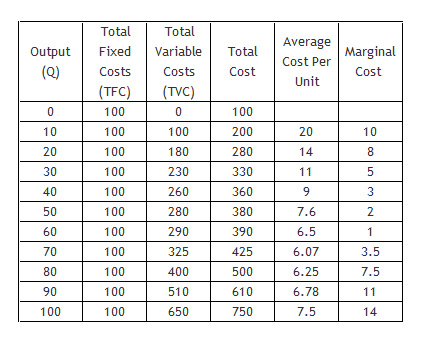
Let’s take a break here for a quick example. Total profit: Total profit is the total amount earned from selling everything produced. Marginal profit: Marginal profit is the amount earned by producing and selling one more unit of production.Īverage profit: Average profit is the average amount earned per unit of production. Sunk costs are a considerable barrier to entry and exit.To understand marginal profit, it is important to differentiate the many “profits”, as confusing the terms with “profit” in them could lead to poor decision making. Examples of sunk costs include spending on advertising and marketing, specialist machines that have no scrap value, and stocks which cannot be sold off. Sunk costs are those that cannot be recovered if a firm goes out of business. The MC curve is the gradient of the TC curve, and the positive gradient of the total cost curve only exists because of a positive variable cost. Marginal costs are derived exclusively from variable costs, and are unaffected by changes in fixed costs.

Total Fixed costs and Total Variable costs are the respective areas under the Average Fixed and Average Variable cost curves. The ATC curve is also ‘U’ shaped because it takes its shape from the AVC curve, with the upturn reflecting the onset of diminishing returns to the variable factor. OUTPUTĪverage total cost (ATC) can be found by adding average fixed costs (AFC) and average variable costs (AVC). Average variable costs are found by dividing total fixed variable costs by output. Average total costs are a key cost in the theory of the firm because they indicate how efficiently scarce resources are being used. Diminishing returns, which cause costs to rise.Īverage total cost (ATC) is also called average cost or unit cost.Increasing returns to the variable factors, which cause average costs to fall, followed by:.

The average variable cost (AVC) curve will at first slope down from left to right, then reach a minimum point, and rise again.ĪVC is ‘U’ shaped because of the principle of variable Proportions, which explains the three phases of the curve: Average variable costsĪverage variable costs are found by dividing total fixed variable costs by output. The average fixed cost (AFC) curve will slope down continuously, from left to right. As fixed cost is divided by an increasing output, average fixed costs will continue to fall. Average fixed costsĪverage fixed costs are found by dividing total fixed costs by output. Its position reflects the amount of fixed costs, and its gradient reflects variable costs. The total cost (TC) curve is found by adding total fixed and total variable costs. The total variable cost (TVC) curve slopes up at an accelerating rate, reflecting the law of diminishing marginal returns. Given that total fixed costs (TFC) are constant as output increases, the curve is a horizontal line on the cost graph. Plotting this gives us Total Cost, Total Variable Cost, and Total Fixed Cost. Total variable costs (TVC) will increase as output increases. The total fixed costs, TFC, include premises, machinery and equipment needed to construct boats, and are £100,000, irrespective of how many boats are produced. Consider the following hypothetical example of a boat building firm.


 0 kommentar(er)
0 kommentar(er)
